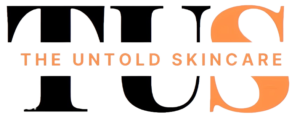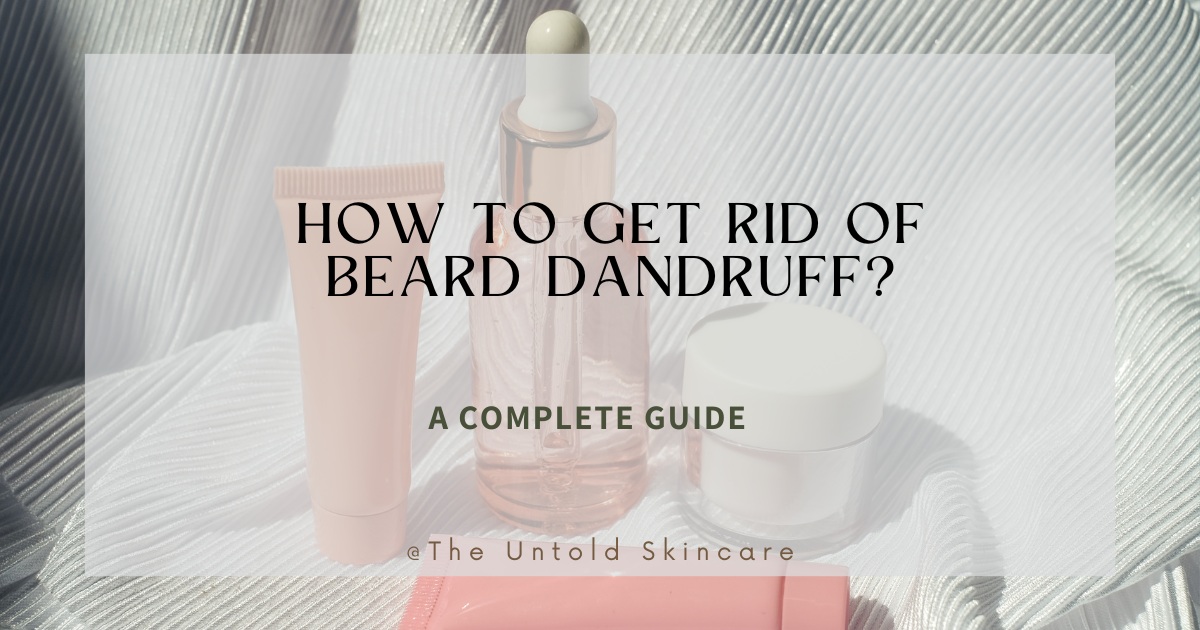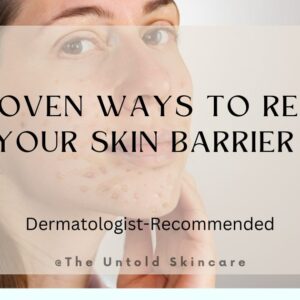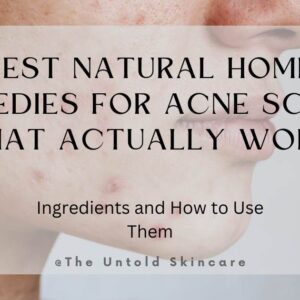Is the region around your beard itchy, inflamed, or covered in white skin flakes? If the answer is yes, you might have beard dandruff problem.
Dandruff is one of the most embarrassing body features that can make you feel really uncomfortable in front of people. It calls into question your hygiene and personal care even if you are doing it correctly.
Beard dandruff is pretty much similar to the scalp dandruff. It is a common skin condition characterized by shedding of dead skin cells. Itchy and flaky skin is frequently present along with it, causing white or greyish skin flakes to show up.
A person’s beard plays a key role in their overall appearance. It must therefore be kept tidy and in good shape. White skin flakes are something you definitely don’t want to have near your face.
It is a common skin problem in most of the men but luckily, it can be prevented.
In this article, I will be covering everything you need to know about beard dandruff. So, if you are someone who’s struggling with it, stay till the end of the article.
What Causes Beard Dandruff?
Beard dandruff can be an irritating and embarrassing problem for many men. Understanding the underlying reasons for this problem is essential to finding a solution. Beard dandruff may be caused by a variety of circumstances, but it is crucial to closely study each one for better prevention and treatment.
You can have beard dandruff because of many reasons. Few major causes are:
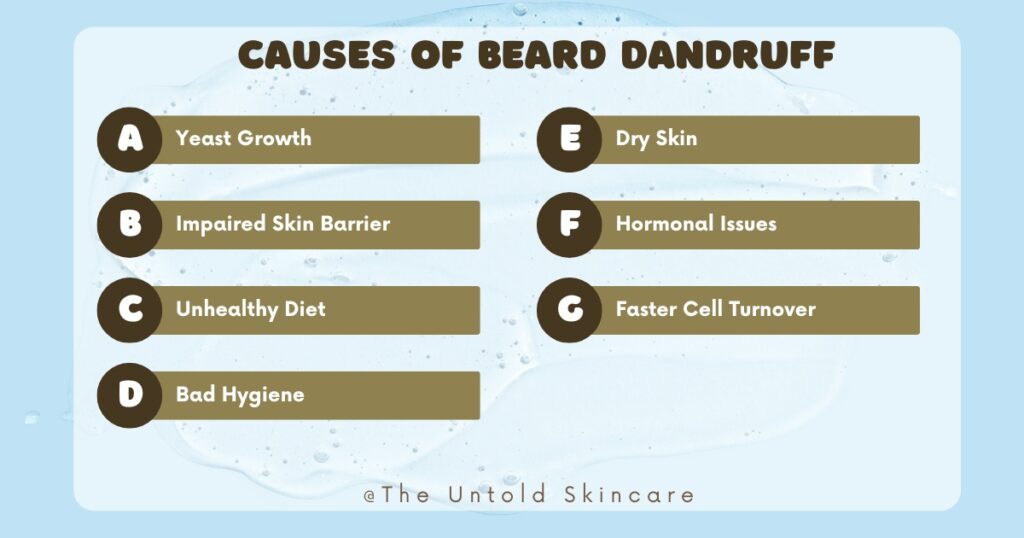
Yeast Growth
A yeast called Malassezia Globosa that lives on human skin is the major culprit of dandruff. It is a yeast that grows on human skin and feeds on oil. So it mostly affects the oily areas of the skin.
This yeast breaks down the natural oil or sebum produced by your body and forms oleic acid which is directly related to skin irritation and dandruff formation. Our body regularly produces oleic acid and it is there to protect the skin but its over-production irritates the skin, making it red and itchy.
About one out of two people is said to have excess oleic acid production in their skin, so it’s a pretty common skin issue.
Impaired Skin Barrier
The skin barrier is an essential barrier that serves as protection from external dangers such as allergies, irritants, and hazardous microbes.
A deficient protective function of the skin is referred to as an impaired skin barrier, which increases the susceptibility of the skin to numerous problems and disorders.
Bacteria and fungus can thrive when the skin’s layer of protection is compromised. Additionally, it causes the skin to itch, which exacerbates the issue as dandruff is directly related to excessive itching.
Unhealthy Diet
An unhealthy diet can significantly contribute to the spread of beard dandruff. Increased blood glucose levels can result from diets rich in sugar and simple carbs. Since fungi enjoy sugar, elevated blood sugar levels might encourage their growth.
Also, excessive oily food intake is directly related to increased sebum production providing a favorable environment for bacteria and fungus growth.
Bad Hygiene
Dandruff isn’t primarily caused due to bad hygiene but it definitely can promote its growth.
If you don’t wash your beard properly, the oil produced won’t get cleaned up. Also, the dirt and dead skin cells will accumulate creating a perfect environment for dandruff causing fungus to grow.
Dry Skin
The skin underneath the beard is usually dry since the beard draws up moisture from the skin surface.
It can also be brought on by a number of other things, including harsh weather, frequent hot water washing, and the use of treatments that remove the skin’s natural oils.
Dry skin causes the skin to shed more dead skin cells, thus making the skin whitish and cracked. Dandruff caused by dry skin is not a skin problem and doesn’t really need any special treatment. You can get rid of that easily by following a simple skincare routine.
Hormonal Issues
Hormonal issues can contribute to dandruff by affecting the sebaceous glands in the skin. Sebum, a natural oil that moisturizes the skin and hair, is produced by these glands. A hormonal imbalance can cause changes in sebum production, which can either cause or trigger dandruff.
A favorable environment for the expansion of the yeast Malassezia can be created when extra sebum and dead skin cells mix.
Faster Cell Turnover
Usually, the normal cell turnover cycle is completed in 30 days. This may speed up sometimes causing high accumulation of dead skin cells on the skin. This can also result in flaky skin.
Is Oily Skin More Prone to Beard Dandruff?
Yes, absolutely!
Since the yeast and funguses feed on oil, they are more likely to affect oily skin.
If you naturally have oily skin, you are more likely to have these microbes in greater density, causing more oleic acid production. So people with oily skin are generally more prone to beard dandruff.
If you have dry skin and are experiencing dandruff, it can just be a dry skin issue. If so, it doesn’t need any special treatment and can be easily solved by following a proper skincare routine.
Could it be Seborrheic Dermatitis?
Seborrheic dermatitis is characterized by red, inflamed skin and severe flaking or scaling. Dandruff and seborrheic dermatitis are quite similar to each other and share common symptoms. However, SD is a more severe problem.
In simple terms, people with seborrheic dermatitis have dandruff all over the face and few other body parts like scalp, chest and back. They have really sensitive skin with a weak skin barrier. The skin looks red and irritated most of the time with quite intense dead skin flakes.
So, if you have dandruff all over the face with an extremely weak skin barrier, it could be seborrheic dermatitis.
But if your dandruff is mild and only limited beneath your beard, it definitely isn’t seborrheic dermatitis. However, it is better to consult a dermatologist in case of any doubt.
What Makes it Worse?
A lot of factors!
Constantly using strong cleansers might dry out your skin and increase your risk of dandruff. Also, a sudden shift in the weather can increase your skin’s susceptibility to dandruff.
Using too many products or switching your products too often or using extremely strong products are also indirectly linked to an increase in dandruff.
Similarly, the growth of dandruff is also significantly aided by excessive consumption of sugar or carbohydrates.
Dandruff on the beard can also be made worse by certain lifestyle choices. Smoking, poor food, stress, and lack of sleep all have an adverse effect on skin health and can cause dandruff to appear.
How to Get Rid of Beard Dandruff?
When it comes to combating beard dandruff, there are several effective solutions available.
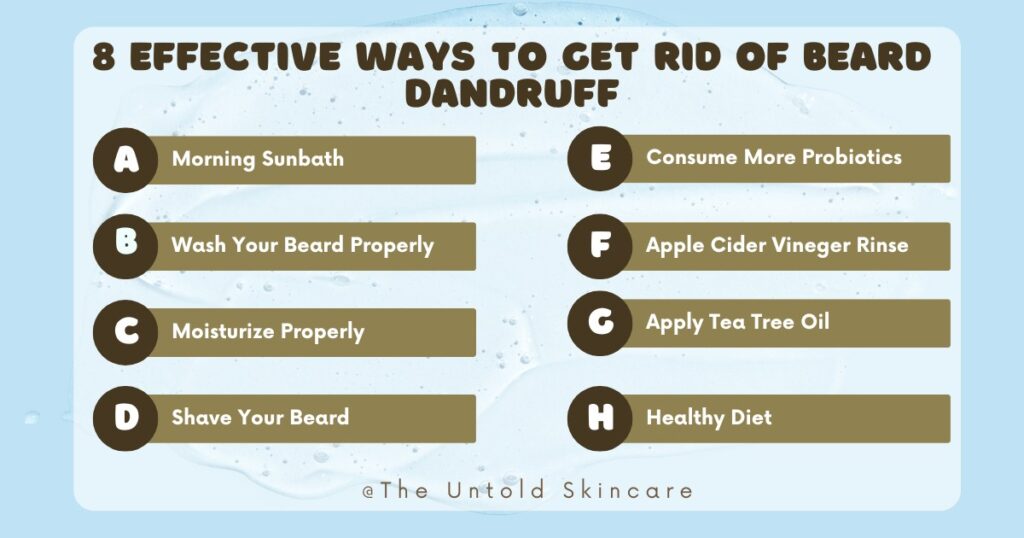
Sunlight Exposure
I don’t think many of you were expecting this one to be on the list but sunlight exposure is extremely helpful in combating dandruff.
Sunlight exposure has mild antimicrobial effects, which help in reducing the growth of bacteria and fungi on the skin. Sunlight can kill some of those funguses, if not, can slow their growth.
Always prefer early morning sun for this purpose. Over-exposure to mid-day sun can increase the risk of other skin problems. About 20-30 minutes of regular morning sun exposure is enough.
Wash Your Beard Properly
Regular cleansing is crucial in combating beard dandruff and maintaining a flake-free beard.
To effectively cleanse your beard, it is recommended to use a mild, sulfate-free beard shampoo or a specialized beard wash. These products are specifically formulated to cleanse without stripping away the natural oils that keep your beard moisturized and healthy.
Gently massage the shampoo or wash into your beard, ensuring that it reaches the skin beneath, and then rinse thoroughly.
Avoid using regular shampoo or harsh, drying soaps, as they can strip away the natural oils that keep your beard and skin moisturized. Look for products that are specifically formulated for beards, as they will be designed to clean without causing excessive dryness.
When washing your beard, make sure to thoroughly rinse out all the shampoo or cleanser. Any residue left behind can contribute to dandruff. Gently pat your beard dry with a clean towel, avoiding harsh rubbing that can irritate the skin.
It’s also important to regularly brush and comb your beard. This helps to remove any loose skin flakes and distribute the natural oils throughout your beard.
Opt for a brush or comb with soft bristles or teeth to avoid causing any irritation or damage to the skin.
Moisturize it Properly
After cleansing, follow up with a beard conditioner or oil to moisturize and nourish both your facial hair and the underlying skin. This step helps to replenish moisture, preventing dryness and minimizing the chances of dandruff formation.
Moisturizing and hydrating the beard and skin are crucial steps in combating beard dandruff. Just like the hair on our heads, the beard and the underlying skin can also suffer from dryness, leading to the dreaded flakes.
To prevent and alleviate beard dandruff, it is essential to incorporate a regular moisturizing routine into your beard care regimen. This involves using high-quality beard oil or balm that is specifically formulated to nourish both the hair and the skin beneath.
Beard oils are typically made with a blend of natural oils such as jojoba, argan, or coconut oil, which have excellent moisturizing properties. These oils penetrate the hair shafts, providing deep hydration and preventing dryness and brittleness.
When applying beard oil, make sure to work it into the skin as well. Massage it gently to stimulate blood flow, which promotes a healthier beard and skin. The moisturizing properties of the oil will help to alleviate dryness and flakiness, giving your beard a more lustrous and healthier appearance.
Shave Your Beard Properly
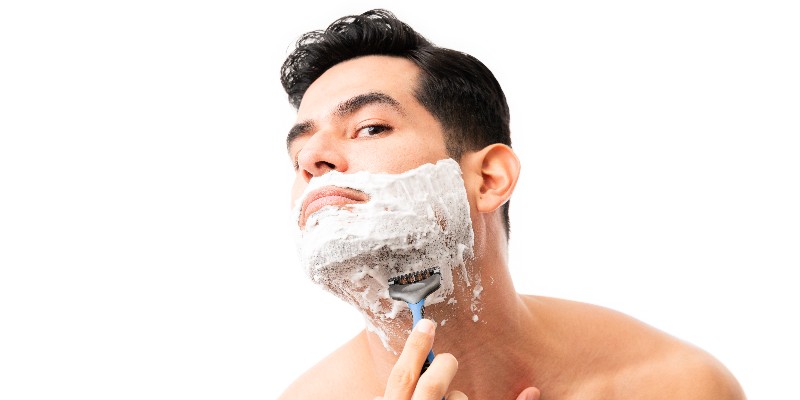
If you have beard dandruff, it is actually quite helpful to shave your beard.
Since hairs can draw moisture from the skin, they can make the skin dry and flaky. Also, the beard can obstruct air circulation to the skin creating a warm and humid environment that is perfect for bacteria to grow.
Beard can also trap dirt and oil which can further worsen the problem. Additionally, cleansing and maintaining hygiene becomes a lot easier when you shave your beard.
Consume More Probiotics

Probiotics can promote a healthy balance of beneficial bacteria in the gut. A balanced gut microbiome can have a positive impact on overall health, including the skin. Skin conditions, including dandruff, can be linked to imbalances in the gut microbiome.
It also helps modulate the immune system, potentially reducing skin inflammation and irritation that can lead to beard dandruff.
Additionally, Probiotics help in the growth of healthy bacteria in the skin that creates a healthy microbiome in the skin.
Apple Cider Vinegar Rinse
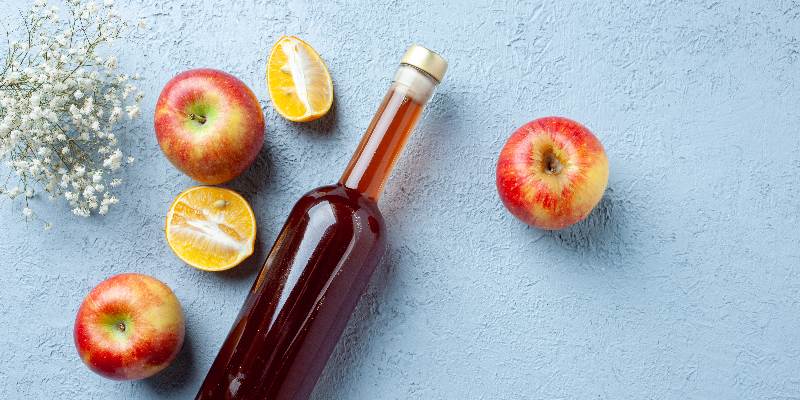
One effective solution for combating beard dandruff is an apple cider vinegar rinse. This natural remedy has gained popularity for its numerous benefits for the skin and hair, and it can also work wonders for your beard.
Apple cider vinegar is known for its antibacterial and antifungal properties, making it an ideal solution for addressing the underlying causes of beard dandruff. Since it is a rich source of probiotics, the good bacteria present in it help in killing the dandruff-causing funguses.
Additionally, it helps balance the pH levels of the skin and hair follicles, preventing excessive dryness or oiliness that can contribute to dandruff.
Make sure you dilute it before using since the undiluted one can be too harsh for anyone’s skin. Usually, one part of ACV and two parts of water is the most balanced proportion.
First, wash your beard properly, then spray the ACV thoroughly and leave it for few minutes. Then rinse it off using lukewarm water. It can be done once or twice a week, generally depending on how severe your dandruff is.
Tea Tree Oil
Tea tree oil possesses powerful antifungal and antibacterial properties. These properties make it an excellent choice for addressing the root causes of beard dandruff, which often stems from fungal or bacterial infections.
Applying a few drops of tea tree oil directly onto the affected areas of your beard can help alleviate itchiness, reduce inflammation, and eliminate the underlying causes of dandruff.
Just like the apple cider vinegar, tea tree oil should also be properly diluted before use. The concentrated form can be too irritating for the skin. It is better to perform a patch test before using it. Do not use more than twice a week.
Healthy Diet

A balanced diet rich in essential nutrients, vitamins, and minerals is crucial for promoting healthy skin and hair.
Make sure to incorporate foods that are known to nourish the skin and combat inflammation, such as fruits, vegetables, whole grains, and lean proteins. Foods high in omega-3 fatty acids, like fatty fish, walnuts, and flaxseeds, can also contribute to a healthier skin.
Hydration is key when it comes to maintaining healthy skin, so be sure to drink an adequate amount of water throughout the day. Proper hydration helps to keep your skin hydrated from within, reducing dryness and flakiness that can contribute to beard dandruff.
When to See a Dermatologist?
If the dandruff persists or becomes severe, it is advisable to consult a dermatologist. They can provide further guidance and recommend specialized treatments such as medicated creams or ointments tailored to your specific condition.
